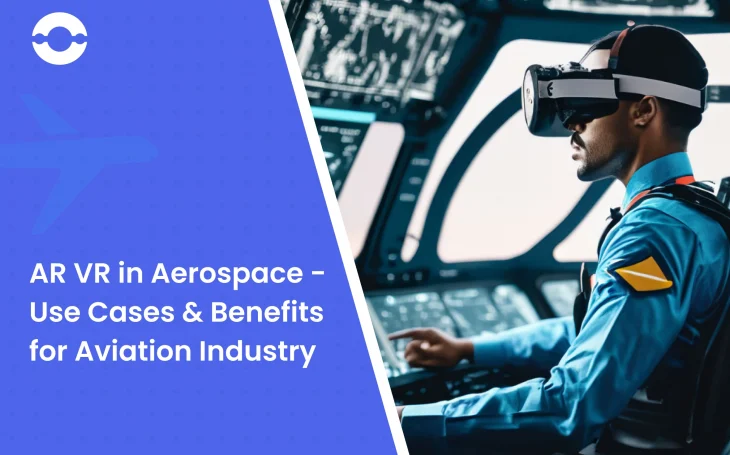
The aerospace industry has already been touched by the digital wave of emerging technologies such as AR and VR.
These technologies are real game changers for aviation companies, streamlining their operations, effectively training their staff, and providing better service to customers.
In this highly competitive industry, aviation companies need to keep themselves up to date with the latest demands and expectations of modern passengers.
The use of AR/VR in aviation allows companies to enhance the customer’s flying experience and keep them visually engaged during their journey.
Moreover, aviation companies can train pilots, cabin crew, and ground crew and provide real-world training experiences in a virtual environment, thus reducing the possibilities of risk associated with flying.
In this blog, we will understand the meaning of AR/VR in aerospace, the benefits of AR/VR in aerospace, and will discuss its applications.
What is AR/VR in Aerospace?
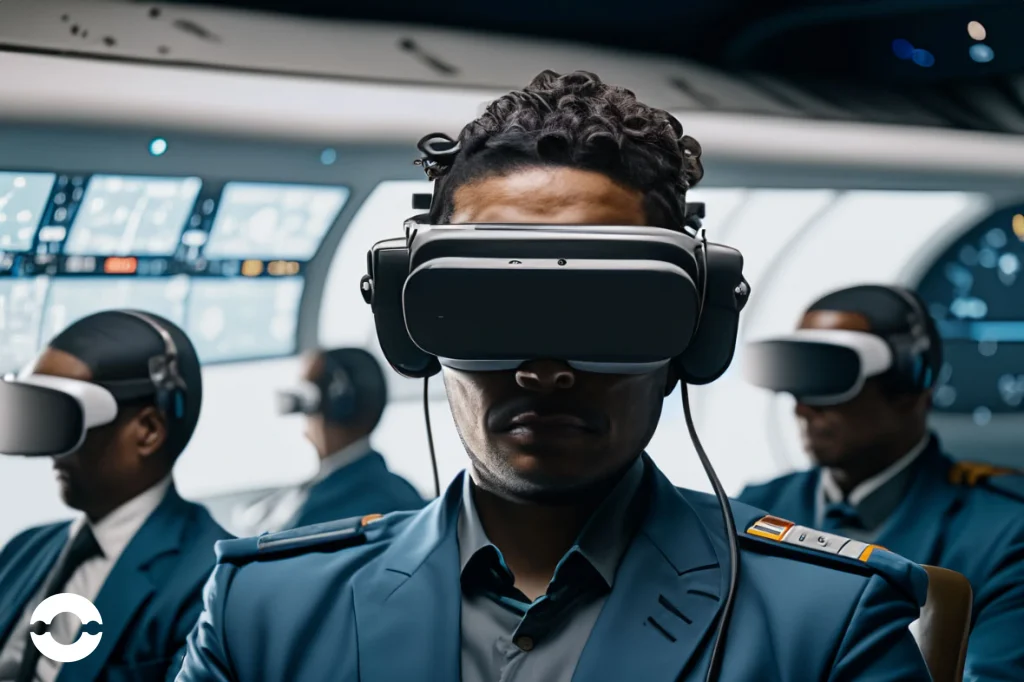
AR/VR contributes an important part to the Aviation industry as it increases the effectiveness of training programs and costs less than traditional means.
Augmented reality in the aviation industry is used for training pilots, manufacturing satellites, teaching engineers, and providing remote maintenance assistance.
AR is an emerging technology that adds virtual elements in the real world, and users can experience these using smartphones/tablets.
In the case of the aviation industry, Augmented reality provides real-time information about weather conditions, other aircraft, and terrain.
Moreover, AR is helpful in maintenance and repair of airplanes. It serves as a guide for maintenance professionals by providing real-time data and information so that they can easily handle complex maintenance tasks.
On the contrary, VR immerses the user in a 3D world and creates more immersive experiences for both professionals and passengers.
VR in aviation revolutionizes aviation space, whether it’s training pilots, inspecting aircraft, or creating an enjoyable experience for passengers.
With virtual reality, training cabin crew now becomes easy. All they need is VR headsets and joystick to get an immersive learning experience, especially for situations like when a plane crashes, passengers fall ill, or in case of hijacks.
Thus, AR and VR technologies prove to be a goldmine for the aviation sector as they create a safer environment, train your staff, and provide entertainment to passengers.
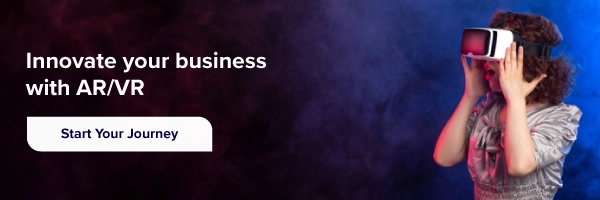
There are many airline companies that leverage the use of VR technology to train their staff.
One such airline company, Boeing, is using virtual training to train astronauts so that they can improve their skills and knowledge.
All they need is a Varjo VR 2 headset to see and interact with virtual aircraft, and they can experience the stress that pilots face when flying an airplane.
Benefits of AR in Aerospace
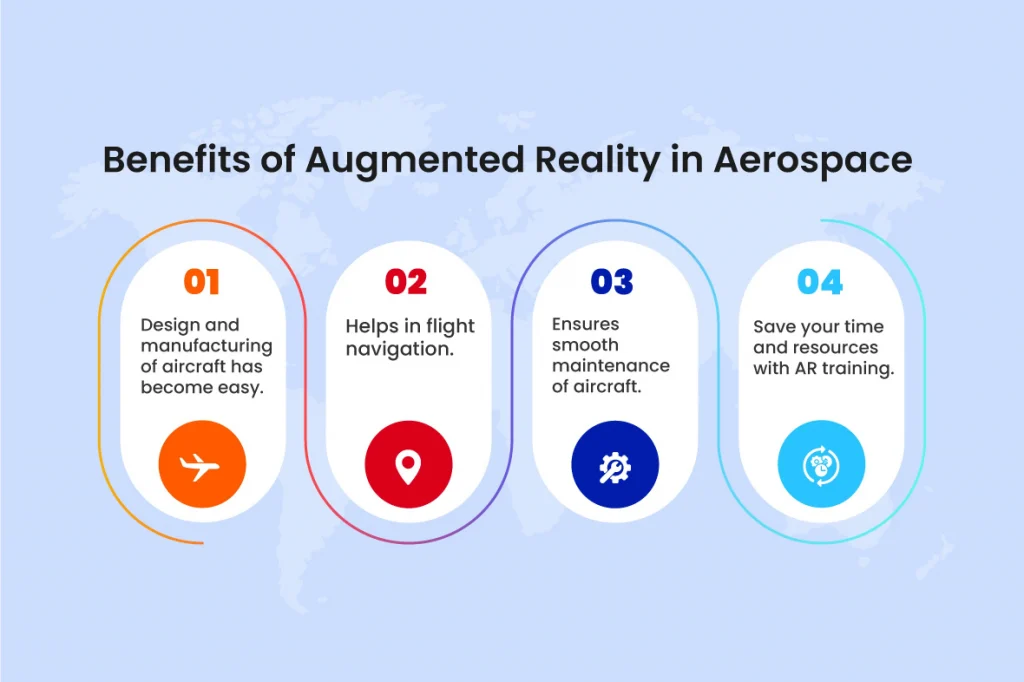
1. Design and manufacturing of aircraft has become easy
Flying an aircraft is considered the safest mode of transportation, but when it comes to flying, several safety concerns arise.
AR/VR technology in aviation scales your manufacturing projects. These technologies allow the engineers to visualize and interact with the digital prototype of an aircraft.
By creating virtual prototypes, engineers and designers visualize aircraft components and spot issues during the design phase.
Integration of AR/VR technologies in manufacturing operations facilitates the quick installation of parts which saves time and effort needed to perform complex assemblies.
2. Helps in Flight navigation
In aviation, AR is not the new technology as it was earlier used for military purposes only.
Integration of AR technology in aviation helps pilots to access real-time information for targeting, navigation, and completing their mission.
This allows the pilots to take the right decisions and provide a safe flying experience to passengers.
3. Ensures smooth maintenance of aircraft
AR brought significant revolution in aviation industry in terms of safety.
Gone are those days when doing routine maintenance checks or referring to user manuals was a time-consuming task.
With AR/VR in aviation, commercial flight engineers get access to real-time insights using technologies such as 3D scanning and sensors. Moreover, they can inspect and maintain parts of aircraft.
Technicians can complete their tasks effectively with minimal distractions and misinterpretations.
When it comes to 3D scanning AR takes the front seat by providing a comprehensive view of aircraft to the engineers. They can easily spot scratches, dents, and other issues in machinery leaving little room for errors.
4. Save your time and resources with AR training
It’s necessary for pilots to have extensive knowledge about real-world flight situations.

While AR improves the effectiveness of training by providing real-world experience to pilots and allows them to practice in virtual environments.
Also, it becomes challenging to provide on-the-job training experience to pilots as most of the time the airport is crowded.
It requires a lot of time and resources to train the personnel and a little mistake might impact the lives of people.
Thus, trainees (ground crew, pilot crew, pilots, etc.) can get an immersive real-life flight environment without any risk to crew or passengers.
NASA for instance used AR technology to train their astronauts so that they could inspect and maintain various areas of space stations.
Benefits of VR in Aviation
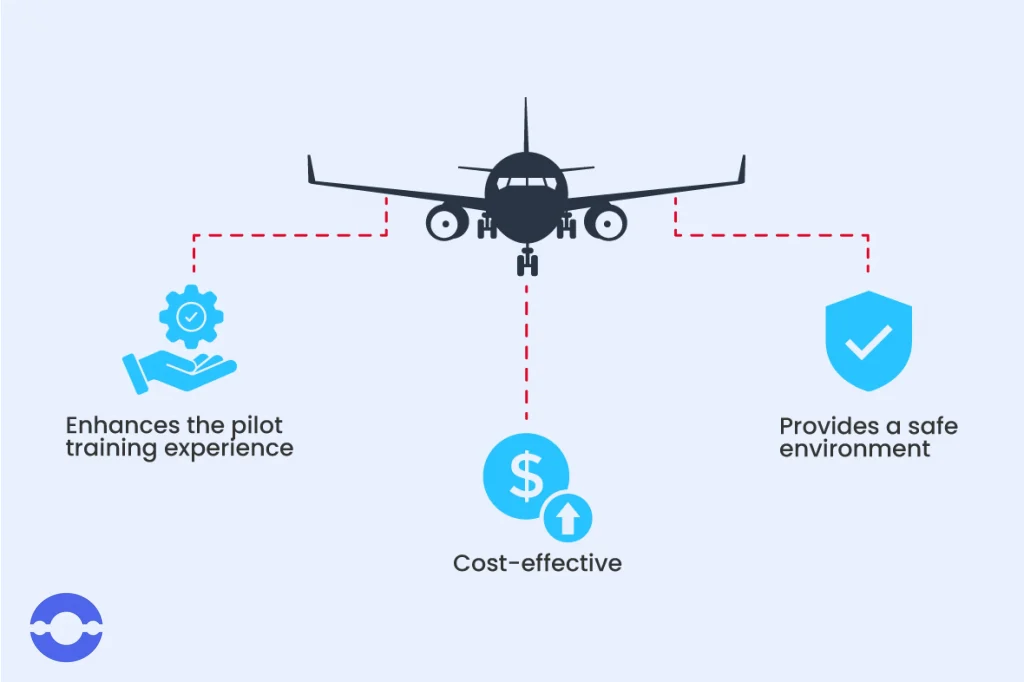
1. Cost-effective
VR technology is cost-effective, as the trainee only needs headsets and flight control to get an immersive experience.
In contrast, if training is imparted through traditional methods, it would add to operational and maintenance expenses such as increased fuel consumption, wear and tear of aircraft, etc.
Thus, pilots can prepare themselves for future challenges because VR technology trains them in a realistic environment.
2. Enhances the pilot training experience
Traditional training programs are expensive and provide limited exposure for training candidates, where they can put their theory to the test.
VR technology on the other hand speeds up the training process, immerses participants in training programs, and helps them become a more competent workforce.
Thus, they can hone their aircraft skills and learn under various conditions on various types of aircraft.
3. Provides a safe environment
Although aviation is considered the safest mode of travel, safety is more crucial in this industry. If staff is trained properly, there would be fewer chances of errors.
Better training helps them detect errors in the early stages, resulting in less damage to someone’s life.
VR provides a safe environment by offering a virtual training experience to your staff. Thus, they can learn to adapt in different situations, settings, and conditions to avoid fatal accidents during actual flights.
Applications (Use cases) of AR/VR in Aviation
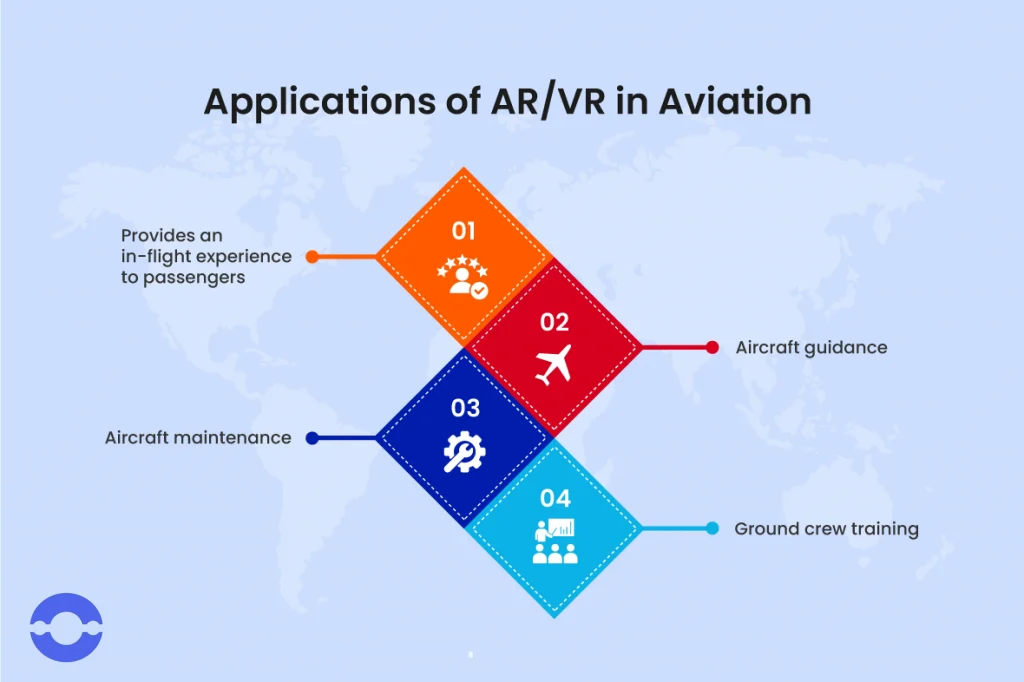
Let’s discuss a few use cases of AR/VR in the aviation industry-
1. Provides an in-flight experience to passengers
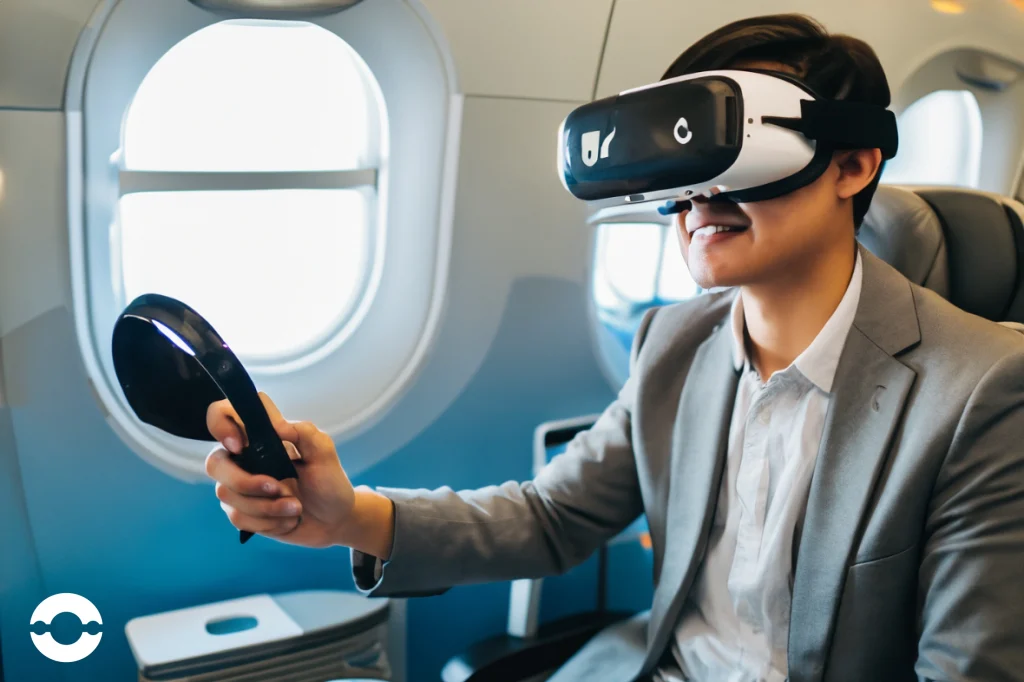
AR/VR technologies in aviation provide immense potential to airline companies, as they can offer in-flight entertainment experiences to passengers.
Such technologies provide a comforting experience for those who dislike flying, as they can immerse themselves in a virtual environment.
Various airlines have invested in VR technology to entertain their customers, where they can enjoy interactive games and relaxation sessions.
Such experiences transform long flights into adventurous sessions.
Lufthansa, for instance, uses VR technology to provide in-flight experiences to customers and allows them to imagine standing on the beach of Mauritius or at the Brooklyn Bridge in New York.
The airlines encourage customers to upgrade from economy class to business class and experience 360-degree video.
2. Aircraft guidance
Undoubtedly, flying is considered the safest mode of transport, with only a 1 in 11 million chance of a crash.
However, half of accidents tend to occur either during landing or takeoff phases. AR technology provides real-time information to pilots about terrain, weather, navigation, etc.
Aero Glass, for instance, uses smart glasses to provide a 360-degree experience to pilots so that they can visualize information without checking multiple screens.
3. Aircraft maintenance
Airline companies are leveraging AR/VR in aviation to inspect and maintain aircraft with precision. They don’t need to find user manuals. With AR glasses, they can get instructions while doing their work.
Thus, maintenance of aircraft becomes easier as the maintenance team can carry out their tasks more effectively.
4. Ground crew training
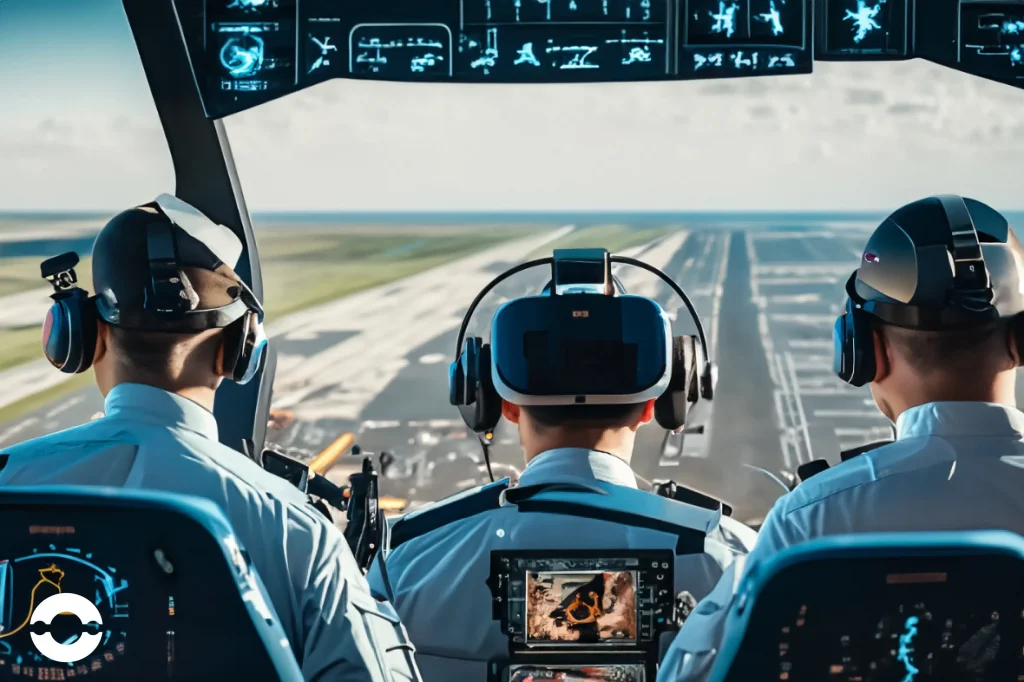
Ground crew staff is responsible for taking care of your plane on the ground.
Virtual reality training provides hands-on experience to ground staff.
It is used to ramp up operations such as aircraft marshaling, loading and unloading of baggage, catering services, etc. It helps ground staff get familiar with aircraft and other surrounding areas.
AR/VR in aviation makes ramp handling processes more efficient so that there is no delay in departure.
By wearing AR glasses, ground crew can perform their tasks safely by following the interactive suggestions displayed on the system.
Wrapping up
From the above blog, you got to know that AR/VR are powerful technologies shaping the aerospace industry.
According to Allied Market Research, the market size of AR and VR in the aviation industry is increasing.
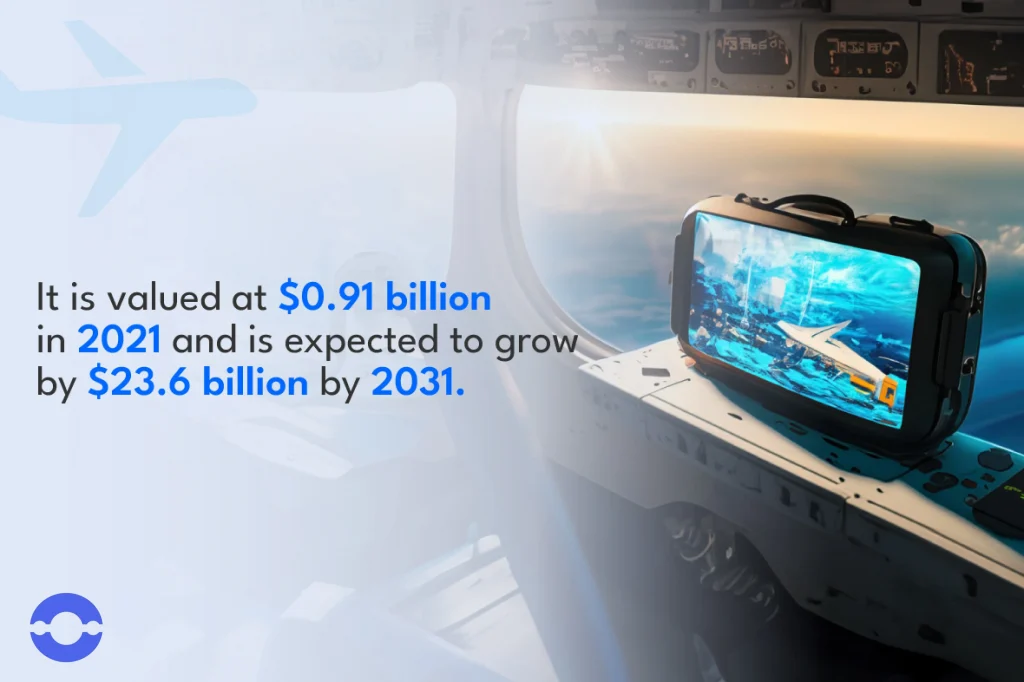
The above figure states that this industry has a lot of potential for aviation companies. AR/VR creates endless possibilities in this domain that goes beyond mere training your staff to providing personalized experiences for your passengers.
The emergence of AR/VR in aviation provides countless benefits, allowing pilots, staff, and other crew members to make the right decisions and save lives.
If you haven’t invested in these advanced technologies such as AR/VR, then it’s the right time for you to employ these technologies so you can stay ahead of others.
At BigOhTech, we offer AR/VR development services to take your business to the next level.
We have a team of 20+ AR/VR experts who are proficient in building innovative AR/VR apps using the latest tools and platforms such as Unity, AR Core, ARKit, Vuforia, etc., increasing your business revenue by 5x.
Also Read: AR And VR In Advertising – Benefits




